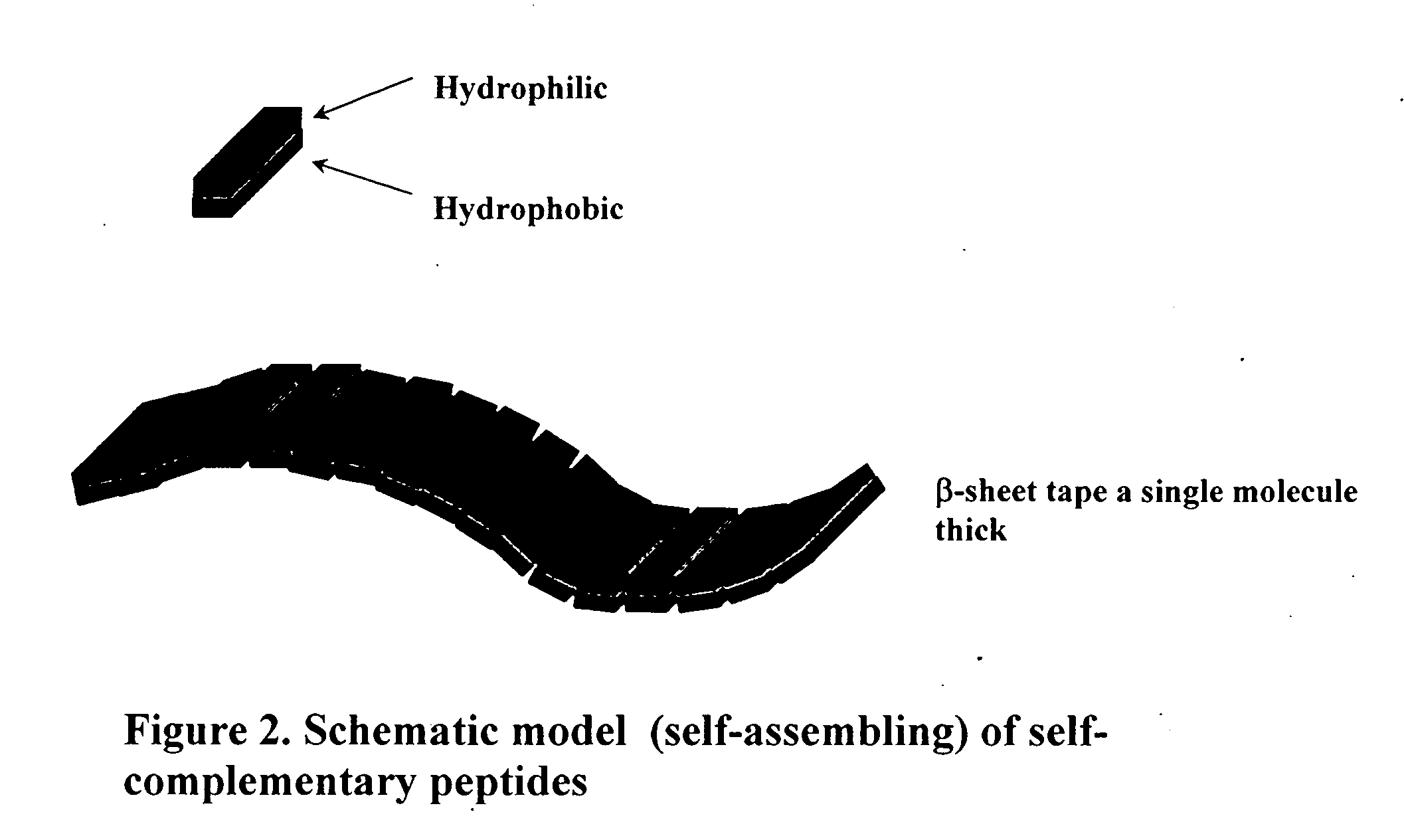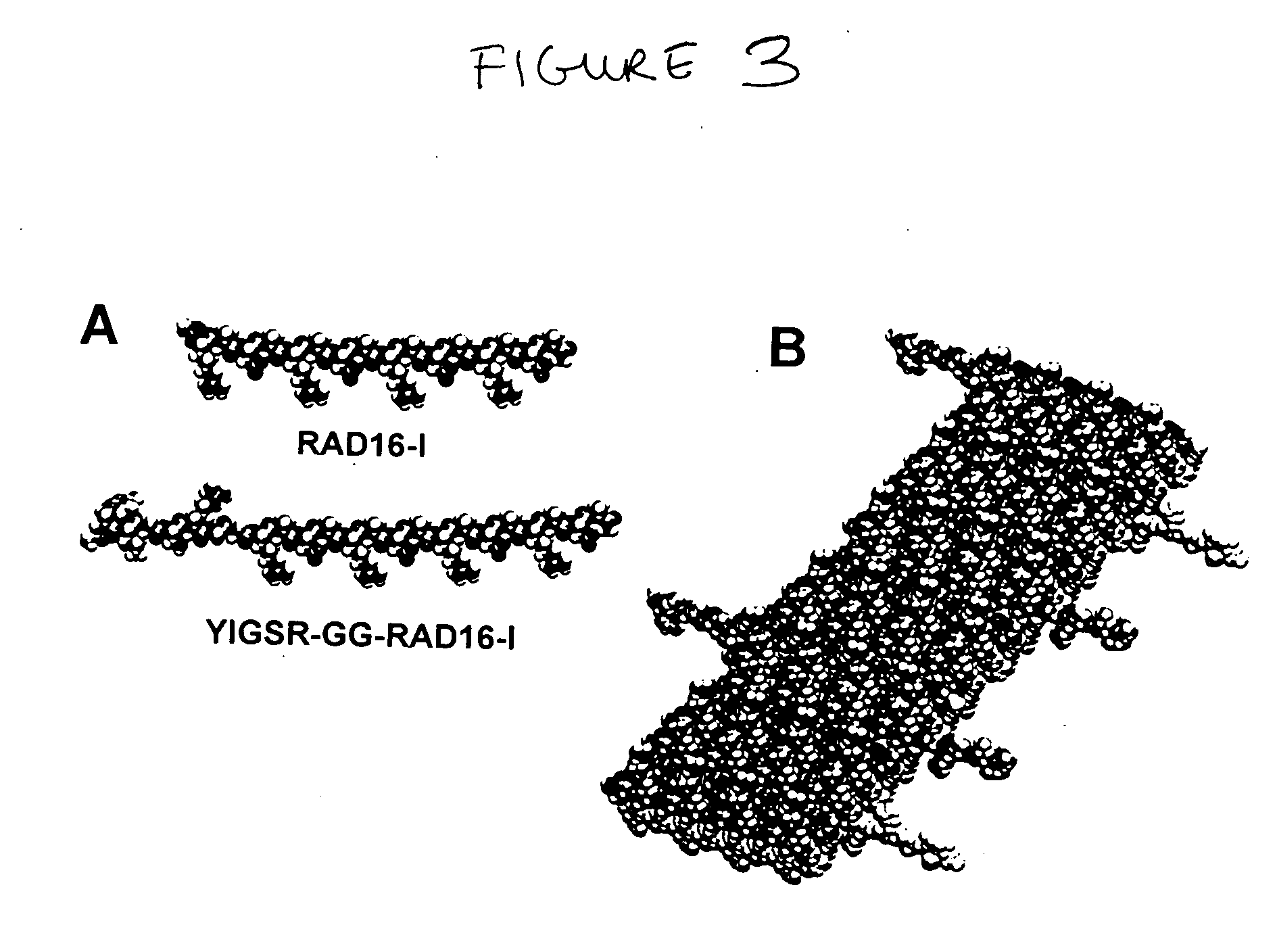Self-assembling peptides incorporating modifications and methods of use thereof
a technology of peptides and modifications, applied in the direction of peptide/protein ingredients, peptide sources, drug compositions, etc., can solve the problems of significant contamination risk, increased risk of disease transmission, and difficulty in ensuring that different preparations of materials have a consistent, reproducible composition
- Summary
- Abstract
- Description
- Claims
- Application Information
AI Technical Summary
Benefits of technology
Problems solved by technology
Method used
Image
Examples
example 1
Physicochemical Characterization of Peptide Scaffolds
Materials and Methods
[0218] Certain of the following materials and methods are relevant to a number of the following examples. Catalog numbers are listed in parentheses.
General Reagents
[0219] PBS: Phosphate buffered saline, 1 mM KH2PO4, 10 mM Na2HPO4, 137 mM NaCl, 2.7 mM KCl, pH 7.4, (166789, Roche Diagnostics Corp., IN).
[0220] Trypsin: Trypsin-EDTA (25300-054, GibcoBRL, US), 0.05% trypsin, 0.53 mM EDTA ·4Na in HBBS, without calcium or magnesium, mycoplasma tested.
[0221] EGM-2: Endothelial semi-defined media (CC-3162, Cambrex, MD) containing hEGF, hydrocortisone, HFGF-B, VEGF, R3-IGF-1, ascorbic acid, gentamicin-amphoterin, heparin and only 2% FBS.
[0222] HAEC: Human aortic endothelial cells (CC-2535, Cambrex, MD).
[0223] Triton-X-100: was purchased from Sigma (T 0284, MO).
[0224] Protease inhibitor cocktail: Complete mini protease inhibitors cocktail was purchased from Roche (1836153, Indianapolis, Ind.).
[0225] TNE: Buffer...
example 2
Endothelial Cell Growth and Monolayerformation on Peptide Scaffolds
Materials and Methods
[0244] Endothelial cell culture system. Peptide scaffolds (0.5% w / v) were prepared at 100% peptide sequence for RAD16-I or blended with RAD16-I at a radio of 9:1 (RAD16-I: peptide sequence, on a volume / volume basis) for the three other cases (YIG, RYV, and TAG). Each solution was filtered (0.2 μm, Acrodysc filters, 4192, PALL, MI), loaded (30 μl) on top of a cell culture chamber insert (10 mm diameter, 136935, Nalge Nunc International, IL), and allowed to form a layer (average thickness=600 μm). Phosphate Buffer Saline (PBS) (600 μl) was added at the bottom of the well to induce hydrogel formation, and the system was incubated at room temperature for 30 min. PBS was replaced with culture medium, which was then replaced with fresh medium. The scaffolds were incubated for 1 hour with endothelial cell growth media (EGM-2, Cambrex, MD) in a cell culture incubator at 37° C. with 5% CO2.
[0245] Meanw...
example 3
Functional Characterization of Endothelial Cells Cultured on Peptide Scaffolds
Materials and Methods
[0258] NO release determination. Nitric oxide (NO) release was estimated by measuring nitrites (NOx) by the Griess method. Briefly, the media was replaced after the third day of culture by new media without fetal bovine serum (FBS) or ascorbic acid. The next day, the media was used to analyze NO release using a commercially available kit (482702, Calbiochem, CA) following the manufacturer instructions. Each condition was tested in triplicate.
[0259] LDL uptake staining. Cells cultured on scaffolds assembled in 96 well dishes were used to perform cell staining. The scaffolds were assembled by placing peptide solution in the wells, followed addition of media to initiate scaffold formation. Cells were incubated for 4 hours with media containing 8 μg / ml of acetylated low density lipoprotein labeled with 1,1′-dioctadecyl-3,3,3′,3′-tetramethylindo-carbocyanine perchlorate (DiI-Ac-LDL, BT-9...
PUM
| Property | Measurement | Unit |
|---|---|---|
| size | aaaaa | aaaaa |
| size | aaaaa | aaaaa |
| size | aaaaa | aaaaa |
Abstract
Description
Claims
Application Information
 Login to View More
Login to View More - R&D
- Intellectual Property
- Life Sciences
- Materials
- Tech Scout
- Unparalleled Data Quality
- Higher Quality Content
- 60% Fewer Hallucinations
Browse by: Latest US Patents, China's latest patents, Technical Efficacy Thesaurus, Application Domain, Technology Topic, Popular Technical Reports.
© 2025 PatSnap. All rights reserved.Legal|Privacy policy|Modern Slavery Act Transparency Statement|Sitemap|About US| Contact US: help@patsnap.com



